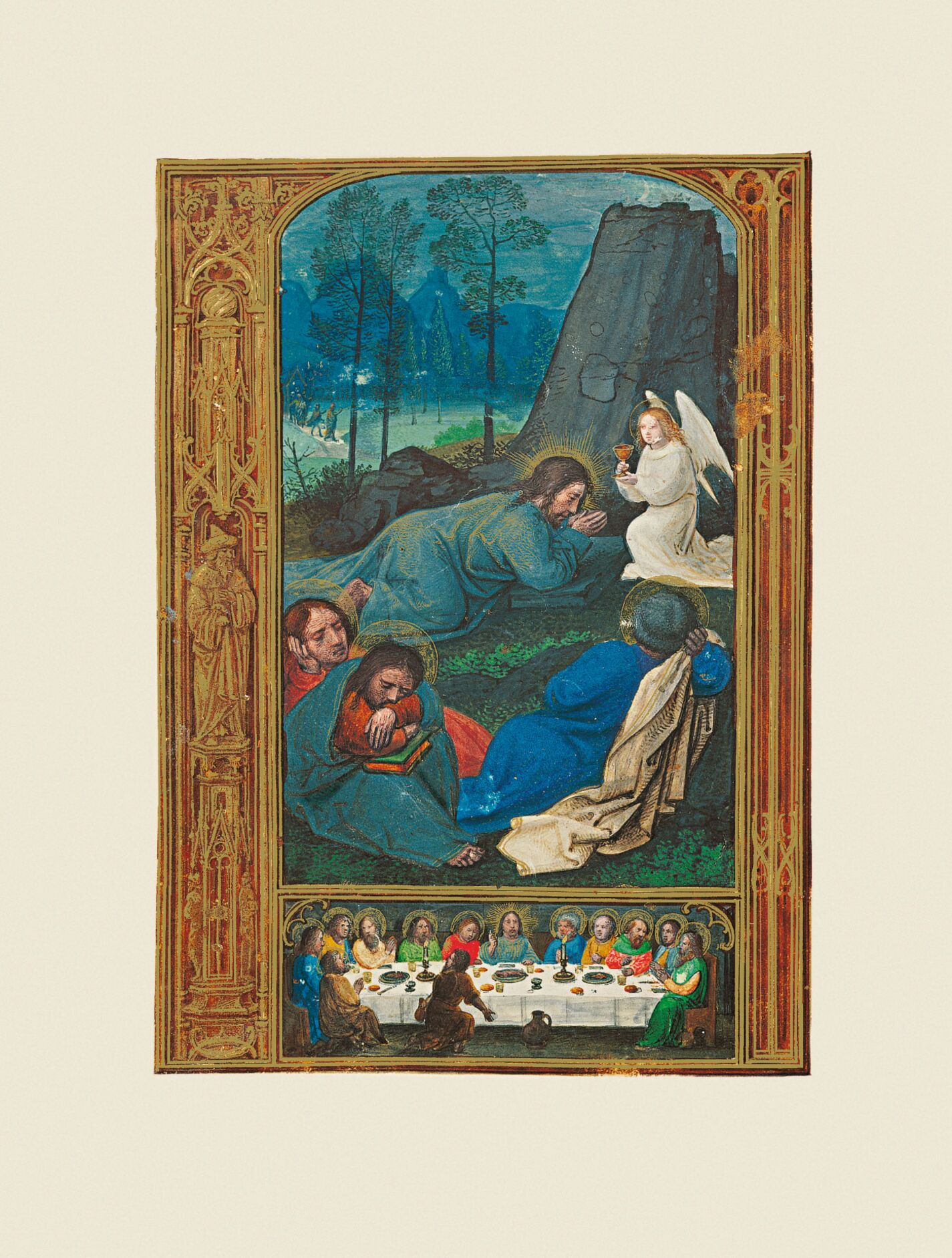The main painting on f. 2v depicting the Agony in the Garden shows the apostles asleep in the foreground with transparent, circular nimbi: St John, beardless to indicate his youthfulness, St Matthew resting with one hand on the book (an attribute referring to his epistle) lying between his knees, and St Peter with grey hair and his back to the viewer. In the mid-ground in front of a large, rocky promontory, is Christ depicted with a radial nimbus and his hands together almost in a proskynesis pose like a priest in front of the altar with a chalice, according to St Mark (14: 35) and St Matthew (26: 39), opposite an angel coming forward to comfort him, according to St Luke (22: 43), holding a golden chalice in his hands. This symbol is an Old Testament symbol of the wrath and judgment of God. In the background of the composition is the garden surrounded by a fence, containing not olive trees but Italian poplars and oaks, and a group of men holding lamps and torches coming in to seize Christ.
The Last Supper depicted in the bottom scene of the folio shows Christ in the centre of a long table flanked by the Apostles, in line with the prototype usual from the 11th century. Christ faces straight forward with his right hand raised in blessing, giving him a solemn appearance reminiscent of that of a pantocrator, alluding to the exaltation of Christ at the moment of the consecration. The separate image of Judas without a nimbus appeared in eastern art from the 6th century onwards on the opposite side of the table from Christ, but always facing him, as in the mosaics at the San Apollinare Nuovo church in Ravenna. As time went by, he was depicted further and further away from the group until finally appearing by himself. This iconographic layout was used from the mid 14th to the 16th century on the walls of Italian refectories. The Last Supper in the Golf Book is based in turn on the scene in the Hennessy Hours, the source of which is an etching dated circa 1498 (Vienna, Graphische Sammlung Albertina, inv. 1952, 366a) of Da Vinci’s Last Supper (Milan, Santa Maria delle Grazie). This mural was surprising from the start for it was unusual for the Last Supper to be depicted in refectories in northern Italy at the moment of the betrayal. Hence the first graphic representations of this work reveal how uncommon this theme was by including an inscription indicating that it is the moment of disloyalty. The copy of Da Vinci’s work was appropriate in the context of the Golf Book, since, within the general pathos that Simon Bening aimed to create, he chose the instant of greatest dramatic tension when Christ suffered most – the pondering of which was to move viewers – when declaring that one of the apostles would betray him. It is, however, possible that the meaning which the Italian painter intended to give his work was not understood by the artists in Simon Bening’s workshop, who preferred to add the iconographical theme of the institution of the Eucharist, for unlike the Milanese work in which Christ leans his hands upon the table, the first manuscript shows the Lord holding the chalice and the second, blessing with his right hand. Although the composition in the Golf Book is not as unsettled as in the other works and Christ’s anguish is less obvious, the other elements in the composition, with the addition of the figure of Judas shown from the back against the light with the bag hanging from his belt, must be considered to be a new variation of the work by the Florentine painter and even of his own work in the Hennessy Hours.
Carlos Miranda García-Tejedor
Doctor in History
